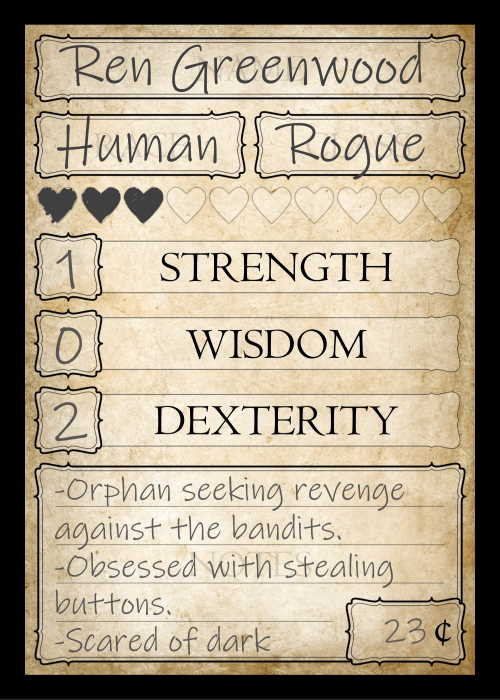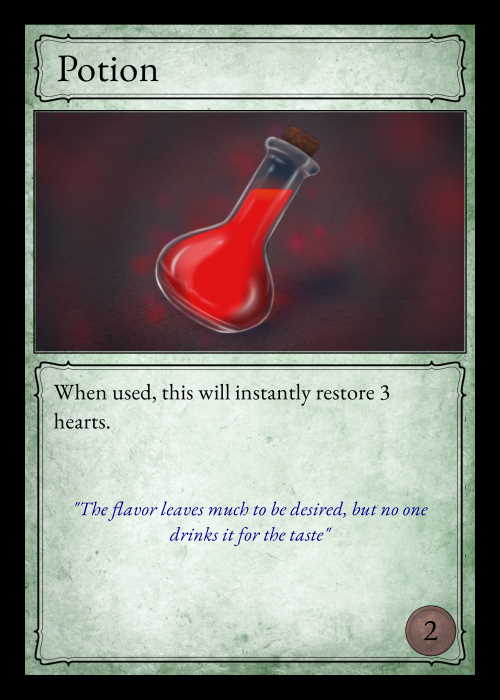The Basics of Penny Quest
Penny Quest is a very special tabletop role-playing game among the rest. Instead of a sheet of paper and multitudes of lines recording skills and items, it uses cards to represent every aspect of the game.
But first, what is a tabletop role-playing game (RPG)? These are games where friends usually gather together (sometimes at a table) and act out a fantasy adventure by taking on the persona of their fictional characters. They can track their characters' growth, acquire wonderful items and fortune, and conquer powerful enemies. These adventures typically span many game nights, building epic stories and memories to share with your friends.
Penny Quest captures the essence of role-playing while simplifying some of the more cumbersome game mechanics common among tabletop RPGs. All aspects of Penny Quest are quick and intuitive while staying flexible.
As with most similar games, one player will run the adventure while the others control their fictional characters. The player who runs the game is known as the Penny Master. They take on the extra responsibility of knowing all the rules, improvising story elements, and controlling the non-player characters during the adventure.

Player Characters
Players' character cards contain basic information about the fantasy hero each player creates, like name, race, and fighting class. Their strengths and weaknesses are represented by four essential values: Hearts, Strength, Wisdom, and Dexterity. These are the only 4 things players have to track during their adventures.
Hearts are the health of a character, tracking damage they take in combat. A player's character may earn up to 10 hearts, but worry not, most attacks will only deal 1 or 2 hearts of damage.
Strength, Wisdom, and Dexterity are the measures of a character's physical power, mental power, and reflexes. Whether in combat or exploring around, these stats and a roll of the dice are used to determine if the player's actions succeed or fail.


Items & Money
Besides hearts and stats, players will become stronger and more protected by the items they carry. Players will earn weapons, armor, and accessory cards that will aid them in battle. They will also acquire item cards that have various uses, such as recovering hearts, trapping an enemy, or other special effects.
In Penny Quest, players are restricted to only 4 items at once. By limiting the number, it makes items simpler and also more valuable. Think of items as an emergency resource instead of a common consumable.
And how do you buy all these amazing items? As the name of the game suggests, the currency players will collect and spend is pennies. While you can write and update each player's currency, the fun of this game comes when you bring a massive bag of real pennies to the table and let everyone get immersed in buying, selling, and looting!


Taking Down Enemies
In most other tabletop games, battles are slow, often confusing, and tedious. Penny Quest makes this fun and intuitive by reducing the dice rolls, keeping the math to a bare minimum, and giving players all the information they need right in their hand.
When attacking, using abilities, or taking any other action against an enemy, players need only roll a 20-sided die and add a small number to see if their action hits. If they hit the enemy, damage is dealt. No more rolls or addings are needed (usually). Some abilities can be a little more exciting.
With Penny Quest, every item or ability you can use in battle is a card, right there in your hand. Abilities are usable once per battle, so just play them down and pick them up after battle.


There are some more detailed rules and extras involved in the game that may come up from time to time, but most interactions and fights go quickly and easily. No one likes waiting forever for their turn, so we chopped the waiting time down.
The Penny Master will want to read through the full Handbook, while the other players can get by just reading the Quick Start Guide first. Both of these can be found on the Downloads page.